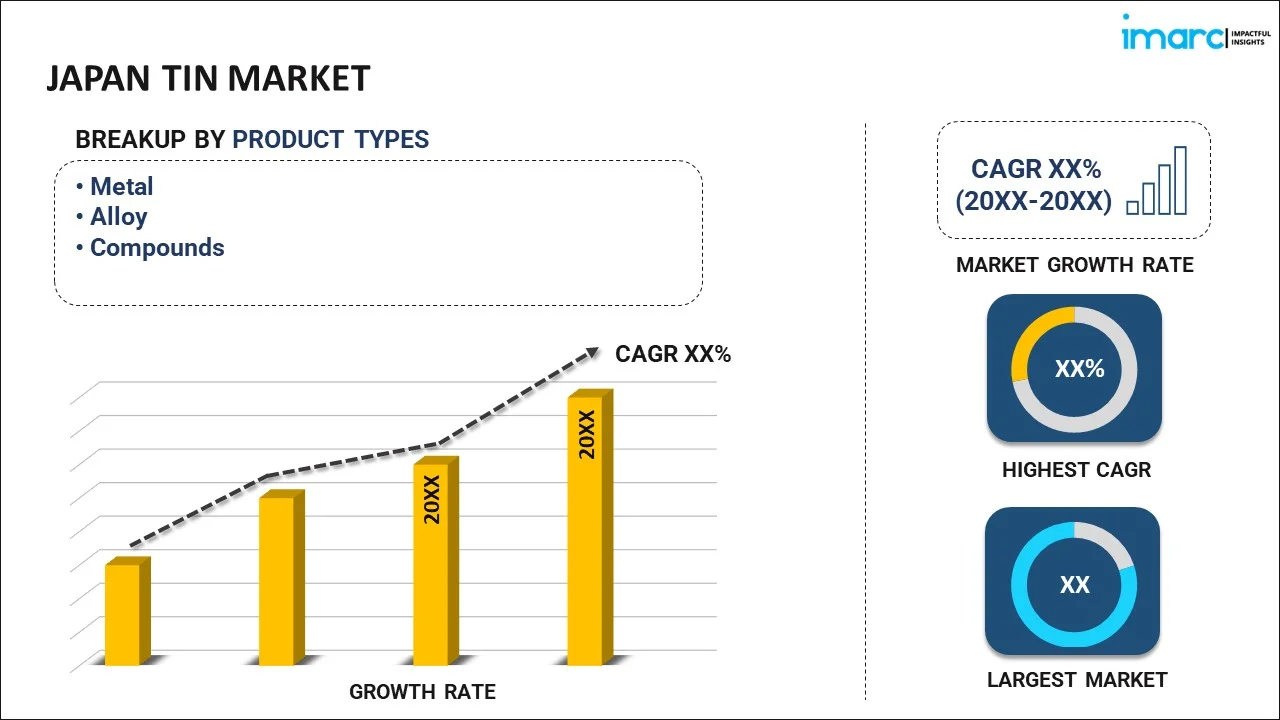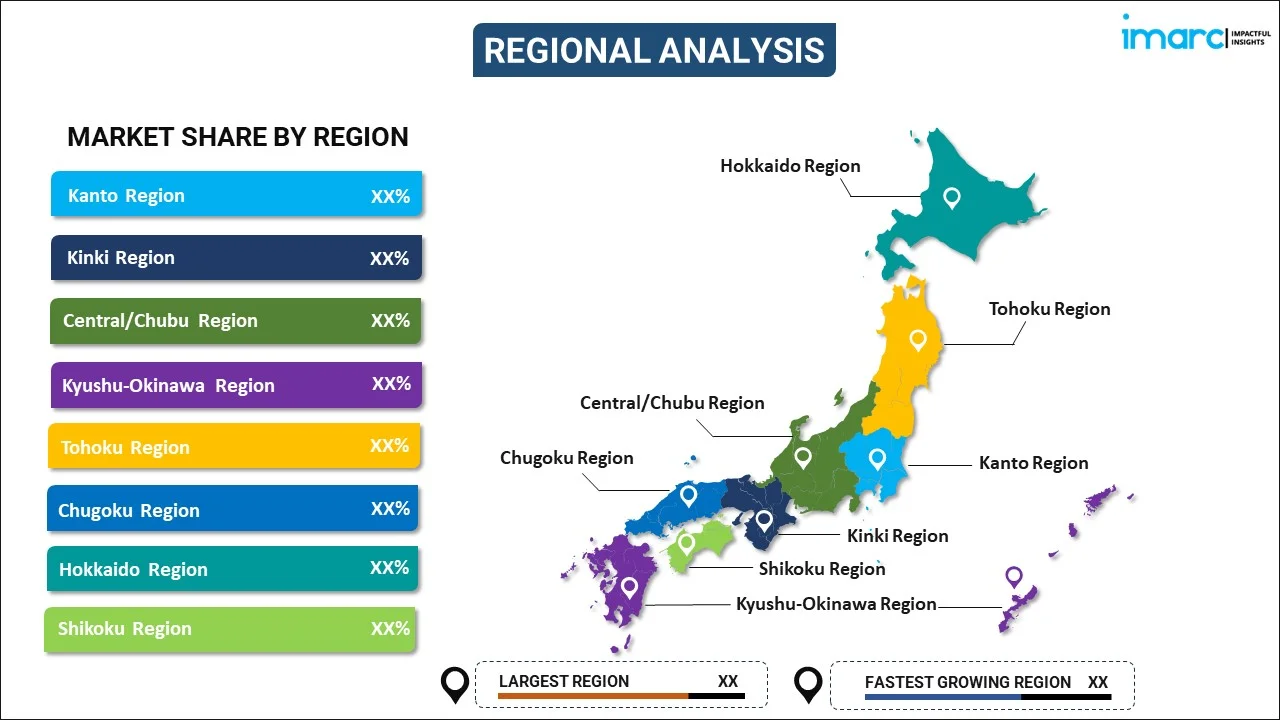
Japan Tin Market Report by Product Type (Metal, Alloy, Compounds), Application (Soldering, Tin Plating, Chemicals, and Others), End Use Industry (Automotive, Electronics, Packaging (Food and Beverages), Glass, and Others), and Region 2025-2033
Market Overview:
The Japan tin market size reached 18.6 Kilo Tonnes in 2024. Looking forward, IMARC Group expects the market to reach 23.3 Kilo Tonnes by 2033, exhibiting a growth rate (CAGR) of 2.3% during 2025-2033. The significant growth of the electronics industry, the widespread product utilization in automotive solder applications, growing emphasis on sustainability and recycling practices and rapidly evolving food packaging industry represent some of the key factors driving the market.
|
Report Attribute
|
Key Statistics
|
|---|---|
|
Base Year
|
2024 |
|
Forecast Years
|
2025-2033
|
|
Historical Years
|
2019-2024
|
| Market Size in 2024 | 18.6 Kilo Tonnes |
| Market Forecast in 2033 | 23.3 Kilo Tonnes |
| Market Growth Rate (2025-2033) | 2.3% |
Tin is a soft, silvery-white metal that belongs to the group of elements known as post-transition metals. It is a chemical element with the symbol "Sn" that belongs to the carbon family of elements on the periodic table. Tin is produced from the mineral cassiterite through smelting and then purified using boiling liquation or electrolytic methods. It is widely used in tin plating, coating, and polishing as it has a high resistance to corrosion. It is soft, ductile, and malleable and has a low melting point, making it easy to work with in various applications. Moreover, it is known for its low toxicity, making it suitable for certain applications in the food and medical industries.
Japan Tin Market Trends:
The significant growth of the electronics industry in Japan is one of the key factors propelling the market growth. Tin is a crucial component in soldering materials used in the assembly of electronic devices and circuit boards. In line with this, the widespread product utilization in automotive solder applications, electrical connectors, and coatings is acting as another growth-inducing factor. Moreover, the growing emphasis on sustainability and recycling practices in various industries encourages the recycling of tin and the development of eco-friendly tin-based products, which is creating a positive outlook for the market. Apart from this, the increasing product adoption in photovoltaic cells for solar panels and their application is crucial in the renewable energy sector and is contributing to the market growth. Additionally, the widespread product application in the manufacturing of industrial degreasers, which are used to remove grease, oil, and contaminants from industrial equipment and machinery, is providing a considerable boost to the market growth. Furthermore, the increasing urbanization and infrastructure projects are facilitating the product demand used in various applications like soldering copper pipes, roofing materials, and electrical wiring. Besides this, the widespread product utilization in the electrical and electronics industry for manufacturing heat-sensitive components due to its low melting point and high magnetic strength is positively influencing the market growth. Other factors, including the rapidly evolving food packaging industry, rising environmentally conscious consumers and regulations, favorable government policies, and emerging trends of recycling tin products, present remunerative growth opportunities for the market.
Japan Tin Market Segmentation:
IMARC Group provides an analysis of the key trends in each segment of the Japan tin market report, along with forecasts at the country level for 2025-2033. Our report has categorized the market based on product type, application, and end use industry.
Product Type Insights:

- Metal
- Alloy
- Compounds
The report has provided a detailed breakup and analysis of the market based on the product type. This includes metal, alloy, and compounds.
Application Insights:
- Soldering
- Tin Plating
- Chemicals
- Others
A detailed breakup and analysis of the market based on the application has also been provided in the report. This includes soldering, tin plating, chemicals, and others.
End Use Industry Insights:
- Automotive
- Electronics
- Packaging (Food and Beverages)
- Glass
- Others
A detailed breakup and analysis of the market based on the end use industry has also been provided in the report. This includes automotive, electronics, packaging (food and beverages), glass, and others.
Regional Insights:

- Kanto Region
- Kinki Region
- Central/ Chubu Region
- Kyushu-Okinawa Region
- Tohoku Region
- Chugoku Region
- Hokkaido Region
- Shikoku Region
The report has also provided a comprehensive analysis of all the major regional markets, which include Kanto Region, Kinki Region, Central/ Chubu Region, Kyushu-Okinawa Region, Tohoku Region, Chugoku Region, Hokkaido Region, and Shikoku Region.
Competitive Landscape:
The report has also provided a comprehensive analysis of the competitive landscape in the market. Competitive analysis such as market structure, key player positioning, top winning strategies, competitive dashboard, and company evaluation quadrant has been covered in the report. Also, detailed profiles of all major companies have been provided.
Japan Tin Market Report Scope:
| Report Features | Details |
|---|---|
| Base Year of the Analysis | 2024 |
| Historical Period | 2019-2024 |
| Forecast Period | 2025-2033 |
| Units | Kilo Tonnes |
| Scope of the Report | Exploration of Historical and Forecast Trends, Industry Catalysts and Challenges, Segment-Wise Historical and Predictive Market Assessment:
|
| Product Types Covered | Metal, Alloy, Compounds |
| Applications Covered | Soldering, Tin Plating, Chemicals, Others |
| End Use Industries Covered | Automotive, Electronics, Packaging (Food and Beverages), Glass, Others |
| Regions Covered | Kanto Region, Kinki Region, Central/ Chubu Region, Kyushu-Okinawa Region, Tohoku Region, Chugoku Region, Hokkaido Region, Shikoku Region |
| Customization Scope | 10% Free Customization |
| Post-Sale Analyst Support | 10-12 Weeks |
| Delivery Format | PDF and Excel through Email (We can also provide the editable version of the report in PPT/Word format on special request) |
Key Questions Answered in This Report:
- How has the Japan tin market performed so far and how will it perform in the coming years?
- What has been the impact of COVID-19 on the Japan tin market?
- What is the breakup of the Japan tin market on the basis of product type?
- What is the breakup of the Japan tin market on the basis of application?
- What is the breakup of the Japan tin market on the basis of end use industry?
- What are the various stages in the value chain of the Japan tin market?
- What are the key driving factors and challenges in the Japan tin market?
- What is the structure of the Japan tin market and who are the key players?
- What is the degree of competition in the Japan tin market?
Key Benefits for Stakeholders:
- IMARC’s report offers a comprehensive quantitative analysis of various market segments, historical and current market trends, market forecasts, and dynamics of the Japan tin market from 2019-2033.
- The research study provides the latest information on the market drivers, challenges, and opportunities in the Japan tin market.
- Porter's five forces analysis assist stakeholders in assessing the impact of new entrants, competitive rivalry, supplier power, buyer power, and the threat of substitution. It helps stakeholders to analyze the level of competition within the Japan tin industry and its attractiveness.
- Competitive landscape allows stakeholders to understand their competitive environment and provides an insight into the current positions of key players in the market.
Need more help?
- Speak to our experienced analysts for insights on the current market scenarios.
- Include additional segments and countries to customize the report as per your requirement.
- Gain an unparalleled competitive advantage in your domain by understanding how to utilize the report and positively impacting your operations and revenue.
- For further assistance, please connect with our analysts.
 Inquire Before Buying
Inquire Before Buying
 Speak to an Analyst
Speak to an Analyst
 Request Brochure
Request Brochure
 Request Customization
Request Customization




.webp)




.webp)












